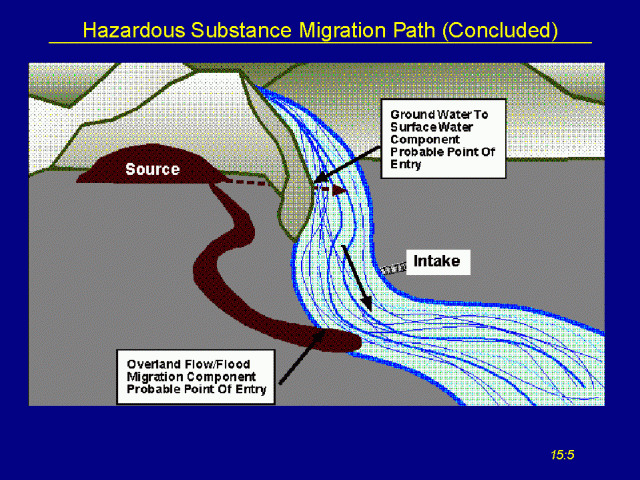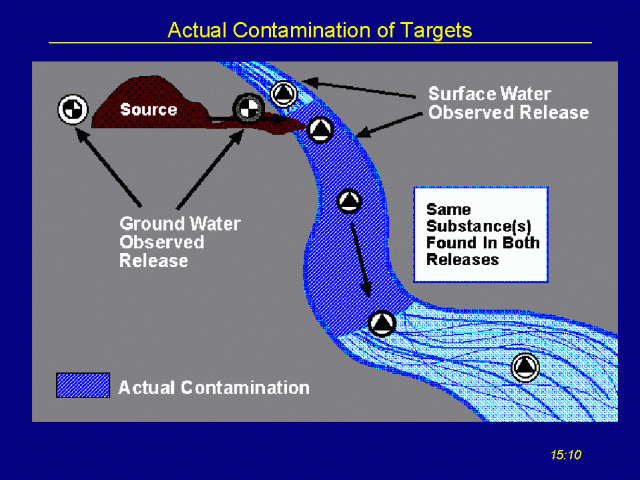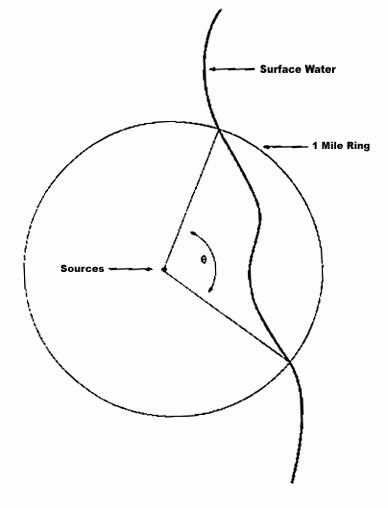Section 15: Surface Water - Ground Water to Surface Water Component
- This component is designed for the special case where surface water targets are threatened by the release of contaminated ground water and where the threat of release by overland flow or flood is minimal.
- It has been applied particularly to old coal gas facilities where the waste is buried deep but alongside a river and polyaromatics have been leaching into the river and threatening surface water targets.
- It has been applied particularly to old coal gas facilities where the waste is buried deep but alongside a river and polyaromatics have been leaching into the river and threatening surface water targets.
- The scores of the two components are not added. Evaluate only the higher scoring.
- The ground water to surface water component will almost always score lower if there is any substantial possibility of release by overland flow or flooding.
- The scoring considerations that make this so will be summarized at the end of this section.
- This component evaluates the same targets as the overland/flood migration component and is broken into the same three threats.
- This section will emphasize only the distinctive features of the ground water to surface water migration component and assumes that you are already familiar with the overland/flood migration component.
HRS rule Table 4-25, pages 51628 to 51629
- This section will emphasize only the distinctive features of the ground water to surface water migration component and assumes that you are already familiar with the overland/flood migration component.
15.1 Hazardous Substance Migration Path
- The overland segment from surface water sources to the probable point of entry (PPE) is replaced by a ground water segment through the uppermost aquifer from ground water sources to a PPE. The in-water segment extends from this PPE to its target distance limit (TDL) and is evaluated for the drinking water threat, the human food chain threat, and the environmental threat.
- Three criteria must be met or this component cannot be evaluated. See below to review the exact wording of the HRS:
- HRS rule, page 51626, Section 4.2.1.1 in entirety

The PPE for this component, which is based on straight-line distance, may be different from the PPE for the overland/flood migration component.

The in-water segments may be quite different for the two components. If this component picks up significant surface water targets that the overland flow/flood migration component misses, rough out a score for both components to determine whether this component is worth evaluation. This is one of the few conditions where this component might yield the higher score.
15.2 Likelihood of Release
- Likelihood of release is evaluated in the same manner as for the groundwater pathway.
- Except, likelihood of release is evaluated only to the uppermost aquifer.
- Except, likelihood of release is evaluated only to the uppermost aquifer.
- In the overland/flood migration component, an observed release to surface water can also document actual contamination of targets. In this component, an observed release to the uppermost aquifer does not establish actual contamination of surface water targets.
15.3 Waste Characteristics
- Evaluate only those quantities that are in a source with a ground water containment value greater than 1. Evaluate only those substances that are found in such a source or are found in an observed release to ground water.
- In the evaluation of the most hazardous substance for each of the three threats, multiply into the evaluation the ground water mobility value for the substance. In other words, the most hazardous substance must be both mobile in ground water and persistent in surface water.
- The impact of this difference is that it usually reduces the value for waste characteristics unless the ground water mobility value for the most hazardous substance is 1.
- Note that substances that have high values for surface water persistence and bioaccumulation usually tend to sorb and, therefore, receive a low value for ground water mobility unless they are found in an observed release to ground water. Conversely, substances that are highly toxic and mobile in ground water frequently have low surface water persistence and bioaccumulation potential.
- Example:
| Substance | Toxicity | Mobility | Persistence | BPFV |
|---|---|---|---|---|
| PCBs | 10,000 | .0001 | 1 | 50,000 |
| Vinyl Chloride | 10,000 | 1 | 0.07 (lake) | 5.0 |
In the evaluation of persistence, the predominant water body type is based on the PPE for the ground water to surface water component.
15.4 Targets
- With the exceptions noted below, the evaluation of targets is the same as for the overland/flood component for the three threats.
- The set of targets may vary because of differences in the PPE and, therefore, in the placement of the TDL.
- The set of targets may vary because of differences in the PPE and, therefore, in the placement of the TDL.
- The documentation of actual contamination in the in-water segment is more demanding for this component.
- It requires the documentation of an observed release to the surficial aquifer and the documentation of an observed release of the same substance(s) to surface water by chemical analysis.

15.5 Potential Contamination of Targets
The values for potential targets are multiplied by surface water dilution weights (HRS Table 4-13) but also by a further dilution weight adjustment. The assumption in the ground water to surface water component is that contaminated ground water will move outward from the sources in all directions and that only that portion that intersects surface water within 1 mile should be included in the potential threat to surface water targets.

Sample Determination of Ground Water to Surface Water Angle
- The angle theta as estimated from this graphic is entered into HRS Table 4-27, page 51631 to determine the additional dilution weight adjustment.
HRS rule, page 51631, Table 4-27 - The impact of theta is to reduce the values of potential targets unless the site is substantially surrounded by surface water.
15.6 Conclusion
- The PPE may not be the same as in the overland/flood component. This may change the set of targets that are picked up by the in-water segment.
- The likelihood of release is the likelihood of release to ground water (the surficial aquifer), not surface water.
- Waste characteristics is based on sources with a ground water contaminant value greater than 0 and included the consideration of ground water mobility as well as surface water persistence.
- Actual contamination in the in-water segment requires that a substance be found in both an observed release to ground water and an observed release by chemical analysis to surface water.
- The values for targets subject to potential contamination are reduced by a second dilution weight based on the angle theta.
- Conclusion:
- This component has proven useful at sites that are well-secured against overland/flood migration but are close to surface water and leaching hazardous substances into surface water.
- Unless these conditions are met, this component will almost always score lower than the overland/flood migration component.
- The evaluation of the two components, with the exceptions mentioned above, is essentially the same.
Continue to Section 16: Air Pathway - Likelihood to Release
Navigate to another section of the course:
Section 1: Regulatory Context of the Hazard Ranking System
Section 2: Site Assessment Process
Section 4: Source Characterization
Section 5: Waste Characteristics
Section 6: Likelihood of Release
Section 8: Groundwater - Aquifers
Section 9: Groundwater - Likelihood of Release
Section 10: Groundwater - Waste Characteristics & Targets
Section 11: Surface Water - Likelihood of Release
Section 12: Surface Water - Drinking Water Threat
Section 13: Surface Water - Human Food Chain Threat
Section 14: Surface Water - Environmental Threat
Section 15: Surface Water - Ground Water to Surface Water Component
Section 16: Air - Likelihood of Release
Section 17: Air - Waste Characteristics & Targets
Section 18: Soil Exposure - Resident Population Threat
